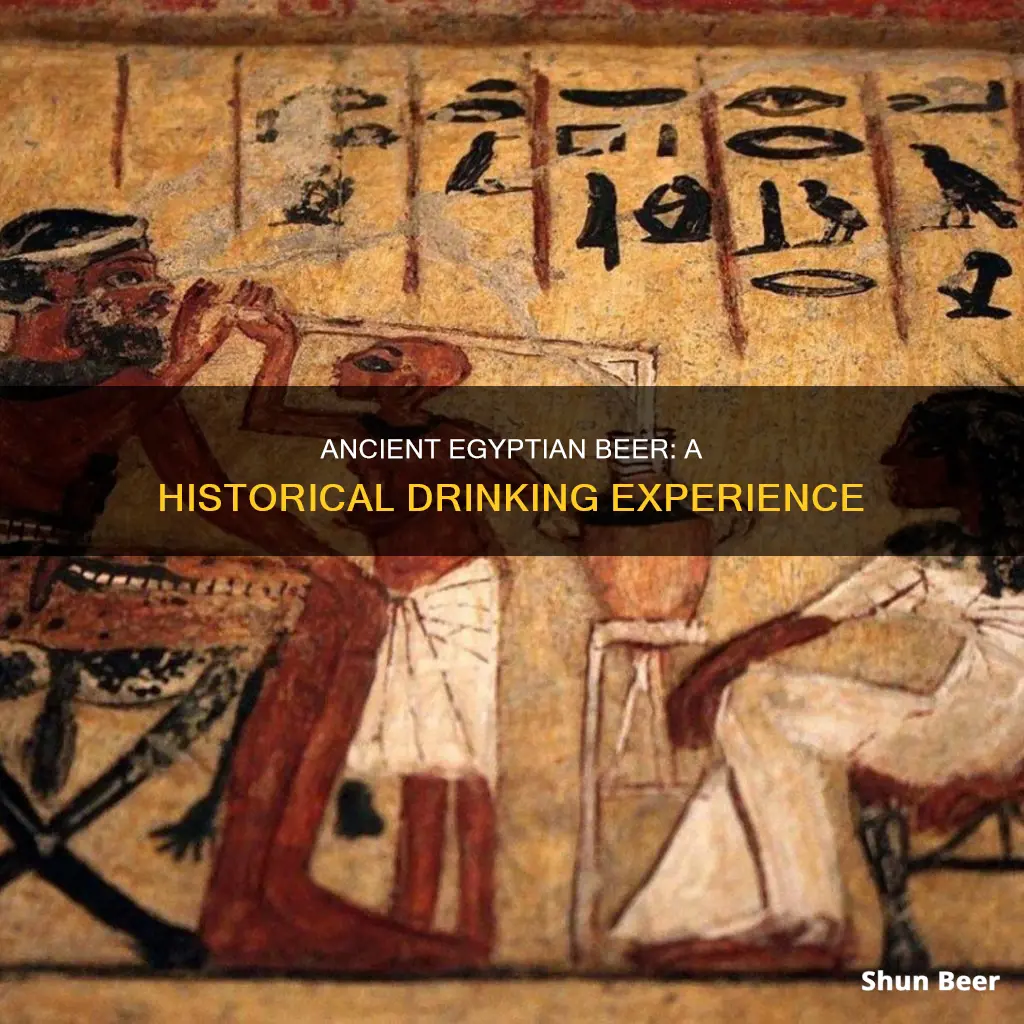
Beer was central to ancient Egyptian society, enjoyed by both adults and children. It was a staple drink for the poor but also featured in the diets of the wealthy. The ancient Egyptian brew was thick, dark red, and sweet, and was made from bread, barley, and emmer (wheat). It was also used as a form of currency, with workers being paid in beer.
| Characteristics | Values |
|---|---|
| Name | "Hqt" ("heqet" or "heket"), "tnmw" ("tenemu"), "haAmt" ("kha-ahmet") |
| Importance | Central to ancient Egyptian society |
| Consumption | Drunk by adults and children of all social classes |
| Diet | A staple food |
| Religious significance | Offered to gods |
| Wages | Often paid in beer |
| Nutritional value | Thick, sweet, and nutritious |
| Intoxication | Could be intoxicating |
| Brewing | Traditionally a female activity |
| Main ingredient | Bread made from a rich yeasty dough, possibly including malt |
| Other ingredients | Dates, barley, emmer, yeast, uncooked malt, mandrakes, olive oil |
| Brewing process | Bread was lightly baked, crumbled into small pieces, and strained through a sieve with water; mixture was then flavoured, fermented in a large vat, and stored in large jars |
| Alcohol content | Average beer had 3-4% alcohol; beer used in religious ceremonies had a higher alcohol content |
What You'll Learn

Beer was drunk by all ages and classes
Beer was central to ancient Egyptian society and was consumed by all ages and classes. It was considered a source of nutrition and was drunk daily by both rich and poor, including children. Beer was also used as compensation for labour, with workers at the Giza plateau receiving beer rations three times a day as payment.
The drink was also an important part of religious ceremonies and festivals. Beer was offered to the gods, and the ancient Egyptian goddess of beer, Tjenenet (or Tenenet), watched over brewers to ensure the best-quality brew. Beer was also central to the festival of Hathor, during which participants would drink to excess and fall asleep to the sound of drums.
Brewing was traditionally a female activity, with women brewing beer in their homes for extra income or bartered goods. However, later on, brewing became a state-funded industry presided over by men.
Non-Alcoholic Beers: A Safe Alternative?
You may want to see also

It was used in religious ceremonies
Beer was central to ancient Egyptian society, and it was used in religious ceremonies. The ancient Egyptians believed that Osiris, the god of agriculture, was the one who discovered beer. According to the myth, Osiris was preparing a decoction of barley with the sacred waters of the Nile when he was distracted and left it out in the sun. When he returned, the mixture had fermented, and he liked the taste so much that he decided to share it with humanity.
The ancient Egyptians certainly held beer in high regard and included it in their religious ceremonies. Beer was offered to the gods, and food and drink would be placed before the deity's statue, which contained their spirit, and the nutrients absorbed supernaturally. Beer was also used in the Opet Festival and the Beautiful Feast of the Wadi, and the Tekh Festival, also known as the Festival of Drunkenness. This festival was dedicated to the goddess Hathor and involved participants drinking to excess and falling asleep in a hall, only to be suddenly awakened by the beating of drums.
The ancient Egyptians also included beer in their funeral rituals. Funerals were a celebration of the deceased's life and included a picnic-banquet where the food and drinks enjoyed by the departed in life would be served, including a quantity of beer. Beer was also placed in tombs as a grave good, as it was considered a necessary offering for the dead.
The ancient Egyptians even had a goddess of beer, Tenenet (or Tjenenet), who watched over brewers and ensured the recipe was followed for the best-quality beer. Beer was so important to the ancient Egyptians that it was used in almost every major festival and was often supplied by the state.
Beer and Kidney Health: What's the Harm?
You may want to see also

It was used as payment for work
Beer was a staple of the Egyptian diet and was also used as a form of payment for work. The drink was so important to the ancient Egyptians that they are known as the first civilisation to perfect the art of brewing beer.
The word for "beer" in ancient Egypt was "heqet" or "heket", and it was also called "tenemu". Beer was consumed by everyone, from pharaohs to peasants, and children also drank it as it was considered a source of nutrition. In fact, workers at the Giza plateau were given beer rations three times a day as payment.
Beer was also used as compensation for labour, referred to as "hemu". This is evidenced by records of payment through beer at various sites throughout Egypt, indicating that the great monuments were not built by slaves but by paid Egyptian labour.
The ancient Egyptians placed value on enjoying life, and this is reflected in their use of beer as a staple food and drink, as well as a form of payment. Beer was also an important part of religious ceremonies and festivals, where drinking to excess was common.
The brewing process for ancient Egyptian beer was quite simple compared to contemporary techniques. It involved mixing grain in cold and hot water, heating the mixture, and then rinsing and fermenting it in a vessel. The beer was then stored in large ceramic jugs or underground, often in a process similar to later lagering.
The use of beer as a form of payment in ancient Egypt highlights its central importance in their society and culture. It was not just a recreational drink but also had practical value as a form of currency.
Sunday Sobriety: Why You Should Avoid Beer This Weekend
You may want to see also

It was considered nutritious
Beer was a staple of the ancient Egyptian diet, drunk by everyone from pharaohs to peasants. It was also used as compensation for work, with workers at the Giza plateau receiving beer rations three times a day as payment.
The drink was considered nutritious, thick, and sweet. The fermentation process added essential B vitamins and amino acids converted from yeast. The main ingredient in the beer was bread made from a rich yeasty dough, possibly including malt. The bread was lightly baked, crumbled into small pieces, and strained through a sieve with water. Flavour was added in the form of dates, and the mixture was fermented in a large vat and then stored in large jars.
There is also evidence that beer was brewed from barley and emmer, which was heated and mixed with yeast and uncooked malt before being fermented. This method was far simpler than contemporary techniques, which see water and grains heated to a certain temperature to control the production of sugars and the beer's alcohol content.
Ancient Egyptian beer was also flavoured with mandrakes, olive oil, and honey. Honey was associated with the gods and was used to brew the highest-quality beer for the king and nobility.
Plant-Based Diets: Beer-Friendly or Not?
You may want to see also

It was flavoured with ingredients like dates and honey
The Ancient Egyptians were known to be avid practitioners of fermentation, and beer was central to their society. It was enjoyed by both adults and children and was considered a source of nutrition.
The Ancient Egyptian brewing process is far simpler than contemporary techniques. The brewers would mix grain in cold water, then heat up another mixture of grain in hot water. They would then combine the two, rinse into a vessel, and ferment.
The Ancient Egyptian beer was flavoured with ingredients like dates and honey. Dates were added for sweetness, and honey was associated with the gods. Honey was also mentioned as a fermentable in the Hymn to Ninkasi, a poem for the goddess of fermentation. The beer found in the tomb of the pharaoh Tutankhamun, for example, was honey beer similar to the later European mead.
In addition to dates and honey, Ancient Egyptians also added yeast to increase fermentation. The beer was thick and dark red, perhaps suggesting the beer originally dyed by Ra to calm and transform Sekhmet.
In later times, during the New Kingdom, the use of dates and honey decreased in the production of common beer. Instead, they were reserved for higher-quality brews for special occasions.
Beer Drinking at National Mall Park: What's Allowed?
You may want to see also
Frequently asked questions
Beer was generally known as "Hqt" ("heqet" or "heket") to ancient Egyptians, but was also called "tenemu" and there was a type of beer known as "kha-ahmet".
The main ingredient in Ancient Egyptian beer was bread made from a rich yeasty dough, possibly including malt. The bread was lightly baked, crumbled into small pieces, and strained through a sieve with water. Flavour was added in the form of dates and the mixture was fermented in a large vat.
Yes, it was central to the diet of both poor and wealthy Egyptians. Beer was also used as compensation for work and was frequently prescribed for health reasons.
Ancient Egyptian beer was thick, sweet, and nutritious. It was also intoxicating and could make you very drunk.







